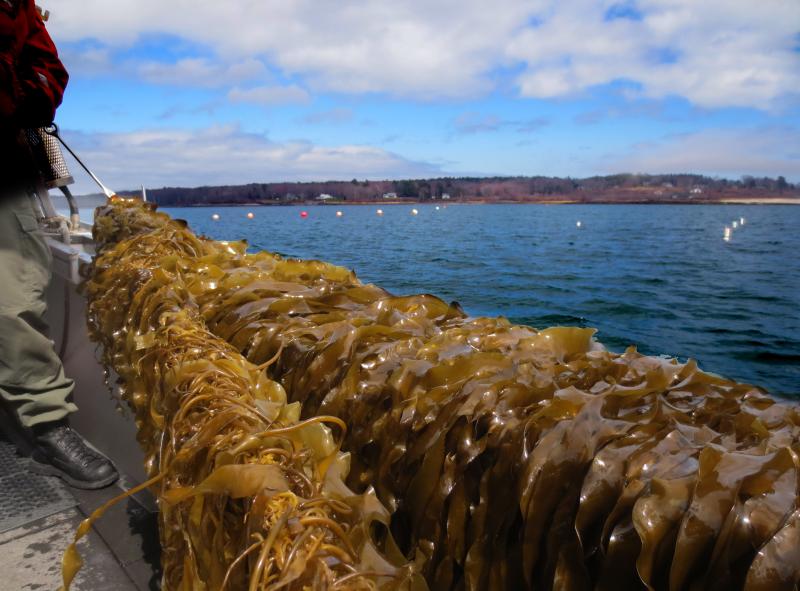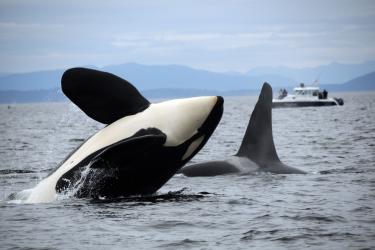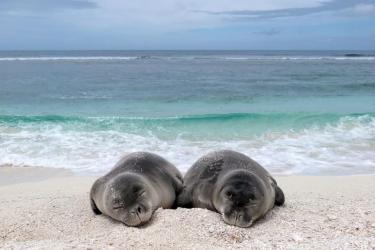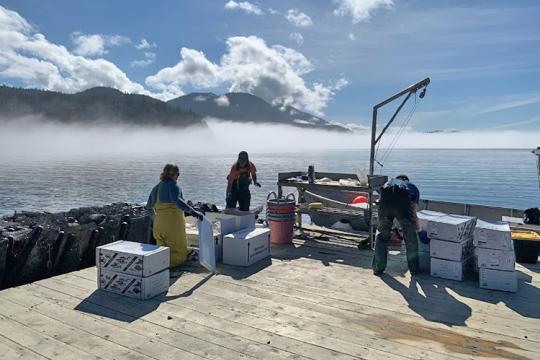This summer the NOAA Fisheries Office of Aquaculture and the American Fisheries Society briefed Congressional members and stakeholders about the benefits of sustainable marine aquaculture. They described how it can reduce carbon, decrease pressure on natural resources, provide ecosystem services, and support climate resilient opportunities for food production.
The briefing, titled “Marine Aquaculture for Climate Resilience and Climate-Friendly Food Production,” featured four presenters from aquaculture-focused organizations:
- Dr. Jesse Trushenski, Ph.D., Chief Science Officer at Riverence, past president of the American Fisheries Society
- Dr. Seth Theuerkauf, Ph.D., Science Coordinator, NOAA Fisheries Office of Aquaculture
- Dr. Rebecca Gentry, Ph.D., Postdoctoral Scholar, Florida State University
- Donald B. Kent, M.S., President and CEO, Hubbs-SeaWorld Research Institute
Video: 'Marine Aquaculture for Climate Resilience and Climate-Friendly Food Production' on Vimeo
In the beginning of the briefing, Dr. Trushenski revealed that in order to meet the demands of our growing global population, “[The world] will need 60 percent more food by 2050. To match our rapidly changing consumption patterns, we will need 60 percent more animal protein by the year 2030.” Intensifying droughts, storms, and other climate-related events have revealed substantial vulnerabilities in current food production systems—including agriculture and fisheries. While not immune to the effects of climate change, panelists discussed how the expansion of farming of fish, shellfish, and seaweeds could reduce resource pressure. They present novel resilience opportunities in light of a changing environment.
Conserving and Complementing Natural Resources
How we produce food and animal protein has effects on the environment. It takes a sizable amount of land and water resources to produce beef, chicken, or pork, and these resources are increasingly strained under climate change. Sustainable aquaculture generally produces similar levels of animal protein while creating fewer greenhouse gas emissions and using fewer land and water resources than land-based livestock.
Farmed fish generally require 2-8 times less feed than poultry, swine, or cattle. Bivalve shellfish and seaweeds rely upon naturally available algae and nutrients, requiring no additional feed inputs from farmers, making farmed seafood a climate-smart protein that can diversify our food production. “Expanding aquaculture to diversify our food production system would allow us to mitigate against disruptions or shocks within any single component of the system, like the effects of drought, disease, or global pandemics which affect different sectors—like livestock production, fisheries or aquaculture—differently,” said Dr. Theuerkauf. Developing aquaculture in the right way in the right places could help buffer the effects of a changing climate on existing food production systems. For example, a prolonged drought could heavily impact cattle farming, but aquaculture requiring little fresh water would not be as affected.
Aquaculture is also critical for our sustainable seafood portfolio. NOAA Fisheries and its partners have made good progress in ending overfishing in the United States through sound, science-based management practices. However, wild fish harvests cannot meet current seafood demands. Aquaculture already contributes a large amount towards meeting the seafood demand-supply gap; half of all seafood produced globally is farm-raised. Worldwide, there is more farmed fish and shellfish produced by farms each year than beef, so the contribution of aquaculture is already significant. Dr. Trushenski added, “Aquaculture matters in terms of first putting food on the table, but also doing so without putting additional pressure on natural resources or a changing climate.”
Providing Ecosystem Services
As oceans become warmer, less oxygenated, and increasingly acidic, dead zones can occur more frequently. This results in the death of fish and wildlife, or species migration in search of more suitable environments. The remaining fish can be less robust and more vulnerable to threats such as the presence of excess nutrients, ocean acidification, and habitat loss.
“Through commercial production of seafood—including seaweeds and shellfish, like oysters and clams—we’re able to achieve benefits such as removal of excess nutrients from water bodies, provision of habitat for wildlife (like juvenile fish of commercial importance), and possibly the buffering of ocean acidification and contributions to carbon burial through seaweed farming,” added Dr. Theuerkauf. That’s why shellfish and seaweed aquaculture has emerged as a promising, low-cost tool to help improve water quality. Currently, waterfronts along the Chesapeake Bay and on Cape Cod are growing shellfish to reduce excess nitrogen in their local waters.
Fact Sheet: Aquaculture Provides Beneficial Ecosystem Services
Planning Enables Sustainability
Spatial planning for where aquaculture can be sited sustainably is a data-driven practice used to find the optimal location for a farming operation. It can help determine the environmental and social factors for the coastal or ocean neighborhood before the aquaculture farm is established.
Siting helps determine where farms can be located to minimize potential environmental impacts and conflicts with other ocean users. It plays a role in ensuring the health of farmed species, and reducing operation costs for farmers. Science-based tools such as NOAA’s OceanReports provide the information needed to help optimally site aquaculture farms for sustainable production with minimal potential impact. “...We can use scientific data and models to ensure that [aquaculture] development is successful from an economic, social, and environmental perspective,” said Dr. Rebecca Gentry.
During the panel, Dr. Gentry demonstrated how an aquaculture farm can be compatible with many existing uses of the ocean. These include wind energy, fishing, protected areas, shipping, military, and recreational areas. She added, “We can ask where aquaculture can be developed that will allow for the maximum value across multiple sectors …We already have data, models, and decision support tools to make good decisions that can account for these factors.”
Growing Coastal Jobs and Reducing Emissions
The United States relies on imported seafood. However, as growing middle classes in Asia and Latin America increase their seafood consumption, imports may become more expensive and harder to acquire. Panelist Donald B. Kent shared the example of yellowtail amberjack, which are primarily imported from Japan, Australia, Hawaii, and Mexico. If the United States can grow its own yellowtail 4 miles off the mainland coast and process it locally, then the nation can cut transportation emissions while still getting healthy seafood to the table.
“We have the technology. We know how to sustainably farm the open ocean … We can produce a ready supply of juvenile fish to be stocked into pens and grown very close to the market,” Kent elaborated.
Aquaculture is not a silver bullet for food production in a changing climate. But expanding responsible marine aquaculture is an important part of a climate-smart food production strategy, that can increase economic and environmental resiliency of rural U.S. communities and strengthen national food security. Further, panelists highlighted how sustainable science-based marine aquaculture can help conserve natural resources, support repair of damaged ecosystems, and combat climate change. With current tools and a focus on sustainability, we can use marine aquaculture to address these challenges while providing new opportunities for economic growth.






